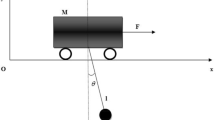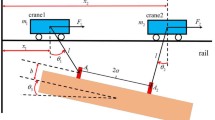Abstract
The study proposes a dynamic model and an adaptive controller for a 3D offshore container crane based on a hierarchical sliding mode control structure and artificial neural network. An overhead-type container crane mounted on a ship with actuator saturation is considered, and its dynamic model is derived from the Lagrange formulation. Hierarchical sliding mode control (HSMC) is utilized to construct the controller structure, while radial basis function (RBF) neural networks are integrated to estimate unknown dynamics and compensate for saturation nonlinearity. The control law is designed to ensure the stability of sliding surfaces, and an updated law for neural network’s weight matrices is constituted from a candidate of Lyapunov function. Simulations and experiments are provided to verify the effectiveness and robustness of the proposed control scheme in offshore conditions containing sea wave excitation and wind force.

























Similar content being viewed by others
References
Almutairi, N. B., & Zribi, M. (2009). Sliding mode control of a three-dimensional overhead crane. Journal of vibration and control, 15(11), 1679–1730.
Bartolini, G., Pisano, A., & Usai, E. (2002). Second-order sliding-mode control of container cranes. Automatica, 38, 1783–1790.
Cho, S. K., & Lee, H. H. (2002). A fuzzy-logic antiswing controller for three-dimensional overhead cranes. ISA Transactions, 41, 235–243.
Craig, J. J. (2009). Introduction to robotics: Mechanics and control, 3/E. Pearson Education India.
Cuong, H. M., Dong, H. Q., Van Trieu, P., et al. (2021). Adaptive fractional-order terminal sliding mode control of rubber-tired gantry cranes with uncertainties and unknown disturbances. Mechanical Systems and Signal Processing, 154, 107601.
Cuong, H. M., Van Trieu, P., Nho, L. C., Thuan, V. D., et al. (2018). Adaptive neural network sliding mode control of shipboard container cranes considering actuator backlash. Mechanical Systems and Signal Processing, 112, 233–250.
Dasgupta, B., & Mruthyunjaya, T. S. (1998). Closed-form dynamic equations of the general Stewart platform through the Newton–Euler approach. Mechanism and Machine Theory, 33, 993–1012.
Fang, Y., Zergeroglu, E., Dixon, W., & Dawson, D. (2001). Nonlinear coupling control laws for an overhead crane system. In Proceedings of the 2001 IEEE international conference on control applications (CCA’01) (Cat. No. 01CH37204) (pp. 639–644). IEEE.
Fujioka, D., & Singhose, W. (2015). Performance comparison of input-shaped model reference control on an uncertain flexible system. IFAC-PapersOnLine, 48(12), 129–134.
Gao, Wenzhi, & Selmic, R. R. (2006). Neural network control of a class of nonlinear systems with actuator saturation. IEEE Transactions on Neural Networks, 17(1), 147–156.
Hong, K. S., & Ngo, Q. H. (2012). Dynamics of the container crane on a mobile harbor. Ocean Engineering, 53, 16–24.
Hung, L. C., & Chung, H. Y. (2007). Decoupled control using neural network-based sliding-mode controller for nonlinear systems. Expert Systems with Applications, 32, 1168–1182.
Hung, L. C., & Chung, H. Y. (2007). Decoupled sliding-mode with fuzzy-neural network controller for nonlinear systems. International Journal of Approximate Reasoning, 46, 74–97.
Jaafar, H. I., Mohamed, Z., Abidin, A. F. Z., & Ab Ghani, Z. (2012). Pso-tuned PID controller for a nonlinear gantry crane system. In 2012 IEEE international conference on control system, computing and engineering (pp. 515–519). IEEE.
Khatamianfar, A., & Savkin, A. V.: A new tracking control approach for 3d overhead crane systems using model predictive control. In 2014 European control conference (ECC) (pp. 796–801). IEEE.
Kim, D., & Park, Y. (2017). Tracking control in \(x-y\) plane of an offshore container crane, jvc/journal vib. control. In Journal of vibration and control (Vol. 23, pp. 469–483).
Kim, G. H., Pham, P. T., Ngo, Q. H., & Nguyen, Q. C. (2020). Neural network-based robust anti-sway control of an industrial crane subjected to hoisting dynamics and uncertain hydrodynamic forces. International Journal of Control, Automation and Systems, 19(5), 1–9.
Lee, H. H. (1998). Modeling and control of a three-dimensional overhead crane. Journal of Dynamic Systems, Measurement, and Control, 120(4), 471–476.
Le, V. A., Le, H., Vu, D. T., Pham, V. T., Le, A. T., Hoang, M. C. (2018). Designing an adaptive controller for 3d overhead cranes using hierarchical sliding mode and neural network. In Proceeding of IEEE international conference on system science and engineering, New Taipei City, Taiwan.
Le, T. A., Kim, G. H., Kim, M. Y., & Lee, S. G. (2012). Partial feedback linearization control of overhead cranes with varying cable lengths. International Journal of Precision Engineering and Manufacturing, 13, 501–507.
Le, V. A., Le, H. X., Nguyen, L., & Phan, M. X. (2019). An efficient adaptive hierarchical sliding mode control strategy using neural networks for 3d overhead cranes. International Journal of Automation and Computing, 16(5), 614–627.
Lu, B., Fang, Y., Sun, N., & Wang, X. (2017). Antiswing control of offshore boom cranes with ship roll disturbances. IEEE Transactions on Control Systems Technology, 26(2), 740–747.
Majid, M. A., Ibrahim, W. S. W., Mohamad, S., & Bakar, Z. A. (2013). A comparison of PID and PD controller with input shaping technique for 3d gantry crane. In 2013 IEEE conference on systems, process & control (ICSPC) (pp. 144–148). IEEE.
Ngo, Q. H., & Hong, K. (2012). Sliding-mode antisway control of an offshore container crane. IEEE/ASME Transactions on Mechatronics, 17(2), 201–209.
Ngo, Q. H., Nguyen, N. P., Nguyen, C. N., Tran, T. H., & Bui, V. H. (2020). Payload pendulation and position control systems for an offshore container crane with adaptive-gain sliding mode control. Asian Journal of Control, 22(5), 2119–2128.
Ngo, Q. H., Nguyen, N. P., Nguyen, C. N., Tran, T. H., & Ha, Q. P. (2017). Fuzzy sliding mode control of an offshore container crane. Ocean Engineering, 140, 125–134.
Park, M., Chwa, D., & Eom, M. (2014). Adaptive sliding-mode antisway control of uncertain overhead cranes with high-speed hoisting motion. IEEE Transactions on Fuzzy Systems, 22(5), 1262–1271.
Park, H., Chwa, D., & Hong, K. (2007). A feedback linearization control of container cranes: Varying rope length. International Journal of Control, Automation and Systems, 5, 379–387.
Park, M., Chwa, D., & Hong, S. (2008). Antisway tracking control of overhead cranes with system uncertainty and actuator nonlinearity using an adaptive fuzzy sliding-mode control. IEEE Transactions on Industrial Electronics, 55(11), 3972–3984.
Park, J., & Sandberg, I. W. (1991). Universal approximation using radial-basis-function networks. Neural Computation, 3, 246–257.
Qian, D., Liu, X., & Yi, J. (2012). Adaptive control based on hierarchical sliding mode for under-actuated systems. In 2012 IEEE international conference on mechatronics and automation (pp. 1050–1055).
Qian, D., Yi, J., & Zhao, D. (2008). Hierarchical sliding mode control for a class of SIMO underactuated system. Control and Cybernetics, 37(1), 160–175.
Qian, D., Yi, J., & Zhao, D. (2011). Control of overhead crane systems by combining sliding mode with fuzzy regulator. In IFAC Proceedings (Vol. 44, pp. 9320–9325).
Ramli, L., Mohamed, Z., Abdullahi, A. M., Jaafar, H., & Lazim, I. M. (2017). Control strategies for crane systems: A comprehensive review. Mechanical Systems and Signal Processing, 95, 1–23.
Shyu, K. K., Jen, C. L., & Shang, L. J. (2005). Design of sliding-mode controller for anti-swing control of overhead cranes. In 31st annual conference of IEEE industrial electronics society (pp. 147–152). IECON.
Solihin, M. I., & Wahyudi, & Legowo, A. (2010). Fuzzy-tuned PID anti-swing control of automatic gantry crane. Journal of Vibration and Control, 16(1), 127–145.
Sun, N., Fang, Y., Chen, H., & He, B. (2014). Adaptive nonlinear crane control with load hoisting/lowering and unknown parameters: Design and experiments. IEEE/ASME Transactions on Mechatronics, 20(5), 2107–2119.
Sun, N., Fang, Y., Chen, H., Wu, Y., & Lu, B. (2017). Nonlinear antiswing control of offshore cranes with unknown parameters and persistent ship-induced perturbations: Theoretical design and hardware experiments. IEEE Transactions on Industrial Electronics, 65(3), 2629–2641.
Thi, K. D. H., Le, V. A., Pham, T. D., Vo, H. T., & Pham, Q.T. (2019). Modeling and integral hierarchical sliding-mode control for 2d ship-mounted crane. In First international symposium on instrumentation, control, artificial intelligence, and robotics (ICA-SYMP) (pp. 82–85). IEEE.
Tsai, C., Wu, H.L., Chuang, K. (2012). Intelligent sliding-mode motion control using fuzzy wavelet networks for automatic 3d overhead cranes. In 2012 proceedings of SICE annual conference (SICE) (pp. 1256–1261).
Tuan, L. A., Ha, Q., Van Trieu, P. (2019). Observer-based nonlinear robust control of floating container cranes subject to output hysteresis. Journal of Dynamic Systems, Measurement, and Control, 141(11).
Tuan, L. A. (2019). Fractional-order fast terminal back-stepping sliding mode control of crawler cranes. Mechanism and Machine Theory, 137, 297–314.
Tuan, L. A., Cuong, H. M., Lee, S. G., Nho, L. C., & Moon, K. (2016). Nonlinear feedback control of container crane mounted on elastic foundation with the flexibility of suspended cable. Journal of Vibration and Control, 22, 3067–3078.
Tuan, L. A., Kim, J. J., Lee, S. G., Lim, T. G., & Nho, L. C. (2014). Second-order sliding mode control of a 3d overhead crane with uncertain system parameters. International Journal of Precision Engineering and Manufacturing, 15, 811–819.
Tuan, L. A., Lee, S. G., Dang, V. H., Moon, S., & Kim, B. (2013). Partial feedback linearization control of a three-dimensional overhead crane. International Journal of Control, Automation and Systems, 11, 718–727.
Tuan, L. A., Lee, S. G., Nho, L. C., & Cuong, H. M. (2015). Robust controls for ship-mounted container cranes with viscoelastic foundation and flexible hoisting cable. Proceedings of the Institution of Mechanical Engineers, Part I: Journal of Systems and Control Engineering, 229, 662–674.
Wang, L., Zhang, H., & Kong, Z.(2015). Anti-swing control of overhead crane based on double fuzzy controllers. In The 27th Chinese control and decision conference (2015 CCDC) (pp. 981–986).
Wang, W., Liu, X. D., & Yi, J. Q. (2007). Structure design of two types of sliding-mode controllers for a class of under-actuated mechanical systems. IET Control Theory & Applications, 1, 163–172.
Wang, W., Yi, J., Zhao, D., & Liu, D. (2004). Design of a stable sliding-mode controller for a class of second-order underactuated systems. IEE Proceedings—Control Theory and Applications, 151, 683–690.
Wu, Z., Xia, X., & Zhu, B. (2015). Model predictive control for improving operational efficiency of overhead cranes. Nonlinear Dynamics, 79(4), 2639–2657.
Xu, W., Zheng, X., Liu, Y., Zhang, M., & Luo, Y. (2015). Adaptive dynamic sliding mode control for overhead cranes. In Proc. 34th Chinese control conf. (pp. 3287–3292).
Yang, B., & Xiong, B. (2010). Application of LQR techniques to the anti-sway controller of overhead crane. In Advanced materials research (Vol. 139, pp. 1933–1936). Trans Tech Publications Ltd.
Yang, J. H., & Yang, K. S. (2007). Adaptive coupling control for overhead crane systems. Mechatronics, 17(2–3), 143–152.
Acknowledgements
This research is funded by International School, Vietnam National University, Hanoi, Vietnam. We would like to thank Viet-Anh Le (Department of Mechanical Engineering, University of Delaware, USA) and Dr. Trieu Van Pham (Vietnam Maritime University) for assisting this study.
Author information
Authors and Affiliations
Corresponding author
Ethics declarations
Conflict of interest
The author declares that there are no conflicts of interest regarding the publication of this paper.
Additional information
Publisher's Note
Springer Nature remains neutral with regard to jurisdictional claims in published maps and institutional affiliations.
6 Appendices
6 Appendices
1.1 6.1 Appendix A
The components of the \({\mathbf{M}}({\mathbf{q}})\) are given as follows:
The elements on the \(\mathbf {C}(\mathbf {q},\dot{\mathbf {q}})\) matrix are expressed as:
The components of the gravitational force vector \(\mathbf {G}(\mathbf {q})\) are presented as:
The elements of the vector of wave-wind disturbance \(\mathbf {W}\) is determined as follows:
where
Rights and permissions
Springer Nature or its licensor holds exclusive rights to this article under a publishing agreement with the author(s) or other rightsholder(s); author self-archiving of the accepted manuscript version of this article is solely governed by the terms of such publishing agreement and applicable law.
Springer Nature or its licensor holds exclusive rights to this article under a publishing agreement with the author(s) or other rightsholder(s); author self-archiving of the accepted manuscript version of this article is solely governed by the terms of such publishing agreement and applicable law.
About this article
Cite this article
Kim, T.D., Nguyen, L. ., Dinh, X. . et al. Adaptive Hierarchical Sliding Mode Control Design for 3D Ship-Mounted Container Crane with Saturating Actuators. J Control Autom Electr Syst 33, 1643–1658 (2022). https://doi.org/10.1007/s40313-022-00939-6
Received:
Revised:
Accepted:
Published:
Issue Date:
DOI: https://doi.org/10.1007/s40313-022-00939-6




